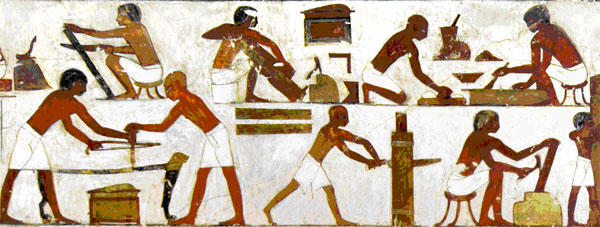The name "kingdom" applies to those periods in Egyptian history when the central government was strong, the country was unified, and there was an orderly succession of pharaohs. When, however, central authority broke down, competing centers of power emerged, these periods are known as "intermediate periods." The Old Kingdom and the Middle Kingdom together represent an important phase in Egyptian political and cultural development. The Third Dynasty reached a level of competence that marked a plateau of achievement for ancient Egypt. After five centuries and following the end of the Sixth Dynasty (ca. 2181 B.C.), the system faltered, and a century and a half of civil war, the First Intermediate Period, ensued. The reestablishment of a powerful central government during the Twelfth Dynasty, however, re-instituted the patterns of the Old Kingdom. Thus, the Old Kingdom and the Middle Kingdom may be considered together.
Divine kingship was the most striking feature of Egypt in these periods. The political and economic system of Egypt developed around the concept of a god incarnate who was believed through his magical powers to control the Nile flood for the benefit of the nation. The cult of the pharaoh, the godking , was expression in the form of great religious complexes .
The pharaoh ruled by divine decree. In the early years, his sons and other close relatives acted as his principal advisers and aides. By the Fourth Dynasty, there was a grand vizier or chief minister, who was at first a prince of royal blood and headed every government department. The country was divided into districts administered by governors. At first, the governors were royal officials who moved from post to post and had no pretense to independence or local ties. Their post eventually became hereditary. Hereditary offices and the possession of property turned these officials into a landed gentry. Concurrently, kings began rewarding their courtiers with gifts of tax-exempt land. From the middle of the Fifth Dynasty can be traced the beginnings of a feudal state with an increase in the power of these provincial lords, particularly in Upper Egypt.
The Old Kingdom ended when the central administration collapsed in the late Sixth Dynasty. This collapse seems to have resulted in part from a period of low Nile waters and great famine. The kings would have been discredited by the famine, because pharaonic power rested in part on the belief that the king controlled the Nile flood. In the absence of central authority, the hereditary landowners took control and assumed responsibility for maintaining order in their own areas. The manors of their estates turned into miniature courts, and Egypt splintered into a number of feudal states. This period of decentralized rule and confusion lasted from the Seventh through the Eleventh dynasties.
The kings of the Twelfth Dynasty restored central government control and a single strong kingship in the period known as the Middle Kingdom. The Middle Kingdom ended with the conquest of Egypt by the Hyksos, the so-called Shepherd Kings. The Hyksos were Semitic nomads who broke into the Delta from the northeast and ruled Egypt from the eastern Delta.
Pyramid Building in the Old and Middle Kingdoms
With the Third Dynasty, Egypt entered into the five centuries of high culture known as the Pyramid Age. The age is associated with Imhotep, the adviser, administrator, and architect of Pharaoh Djoser. He built the pharaoh's funerary complex, including his tomb, the Step Pyramid, at Saqqarah. Imhotep’s architectural genius lay in his use of durable, fine-quality limestone to imitate the brick, wood, and reed structures that have since disappeared.
The first true pyramid was built by Snoferu, the first king of the Fourth Dynasty. His son and successor, Cheops, built the Great Pyramid at Giza. This, with its two companions on the same site, was considered one of the wonders of the ancient world. It contained well over 2 million blocks of limestone, some weighing fifteen tons apiece. The casing stones of the Great Pyramid were stripped off to build medieval Cairo.
The building and equipping of funerary monuments represented the single largest industry through the Old Kingdom and, after a break, the Middle Kingdom as well. The pyramids of the pharaohs, the tombs of the elite, and the burial practices of the poorer classes are related to ancient Egyptian religious beliefs, particularly belief in the afterlife. The Egyptian belief that life would continue after death in a form similar to that experienced on earth was an important element in the development of art and architecture that was not present in other cultures. In ancient Egypt, a dwelling place was provided for the dead in the form of a pyramid or a rock tomb, the walls of the tombs were decorated with pictures of life.


